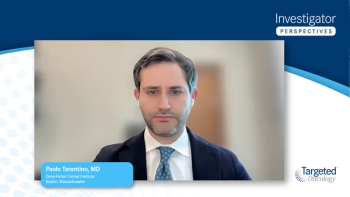
Looking Toward the Future Management of Unresectable HCC
Considerations for ongoing clinical trials that may shape the future treatment landscape of unresectable hepatocellular carcinoma.
Episodes in this series
Richard Kim, MD: With atezolizumab plus bevacizumab being the standard first-line treatment, there are other phase 3 studies underway in the first line. Most of the studies are comparing to the control arm of a TKI [tyrosine kinase inhibitor], whether it’s lenvatinib or sorafenib. There are no trials right now against atezolizumab plus bevacizumab. There are combinations of a TKI plus immunotherapy [IO]. There’s the COSMIC-312 study, where we are combining cabozantinib plus atezolizumab, a checkpoint inhibitor. There’s the LEAP-002 study, where we’re combining lenvatinib with pembrolizumab, another checkpoint inhibitor. The rationale for combining those 2 classes is that the TKI can change the microenvironment. All those TKIs have anti-VEGF properties as well. You could change the microenvironment so that it could be synergistic with the checkpoint inhibitors. Now, a lot of early data show a very promising outcome with that combination. Recently, regarding the COSMIC-313 data, there was a press release telling us that the combination of cabozantinib plus nivolumab showed an improvement in PFS [progression-free survival] but no improvement in overall survival. This was just a press release. We need to get more data in terms of what that number really means. There’s another trial, the LEAP-002 study, which is a combination of lenvatinib plus pembrolizumab in the phase 3 setting. That’s a trial that’s already finished accrual. We’ll wait to hear what the results of that trial show.
Another combination that’s been studied in the first line is a combination of 2 immunotherapy agents, a checkpoint inhibitor with a CTLA-4 inhibitor. There’s the CheckMate 9DW study combining nivolumab plus ipilimumab, and there’s the HIMALAYA study, which is another trial combining 2 immunotherapy agents. The HIMALAYA study is combining durvalumab plus tremelimumab. That trial has already finished accrual. We’re eagerly awaiting the results of those studies. When those trials read out, then you may have a couple of combination therapies available in the first line: not only with atezolizumab plus bevacizumab, but with an option of using a TKI plus IO, or using an IO plus IO. We’re eagerly awaiting the results of those phase 3 studies.
For the patient’s sake, you may have more options available if those trials are positive. If those trials are positive, as clinicians, we will have to decide which we want to use. I think the devil will be in the details in terms of which regimen to use. I think efficacy does matter, in terms of how effective they are. I also think the safety profile matters a lot because unfortunately, we’re not curing any of these patients. We are mostly prolonging their lives. But their quality of life is very important. The safety profile will be important as well. We’re eagerly anticipating the results of all those phase 3 studies underway. Hopefully, there are some other studies that will be positive, which will lead to more indications in this setting.
In the treatment of hepatocellular carcinoma, we’ve come a very long way. In the past, as medical oncologists, we didn’t have much to offer except sorafenib. It was mostly a disease treated by interventional radiologists and hepatologists. But with the evolvement of all these new drugs—TKIs and immunotherapy, checkpoint inhibitors now being approved or being studied—as medical oncologists, we should get more heavily involved earlier in treating these patients. One of the things a community oncologist should do is, as I mentioned, the multidisciplinary approach, which is very important. It’s a must. We have to get everybody at the table, to go with the same plan. But with all these drugs available, we should treat them a lot earlier. In the past, there were a lot of cases where local therapy failed. Despite that, the patients were getting more local therapies, for example. But now, if they fail local therapy or if they’re refractory to local therapy, we should treat those patients more aggressively with all the combinations available. Based on the IMbrave150 study, the median survival is hovering close to 20 months. This is the longest overall survival we’ve seen with advanced disease. As the treatment paradigm evolves in hepatocellular carcinoma, it is very important for us, medical oncologists, to get involved earlier in conjunction with interventional radiologists and offer patients treatment that could potentially give them a good quality of life and prolong their overall survival.
Transcript edited for clarity.







































